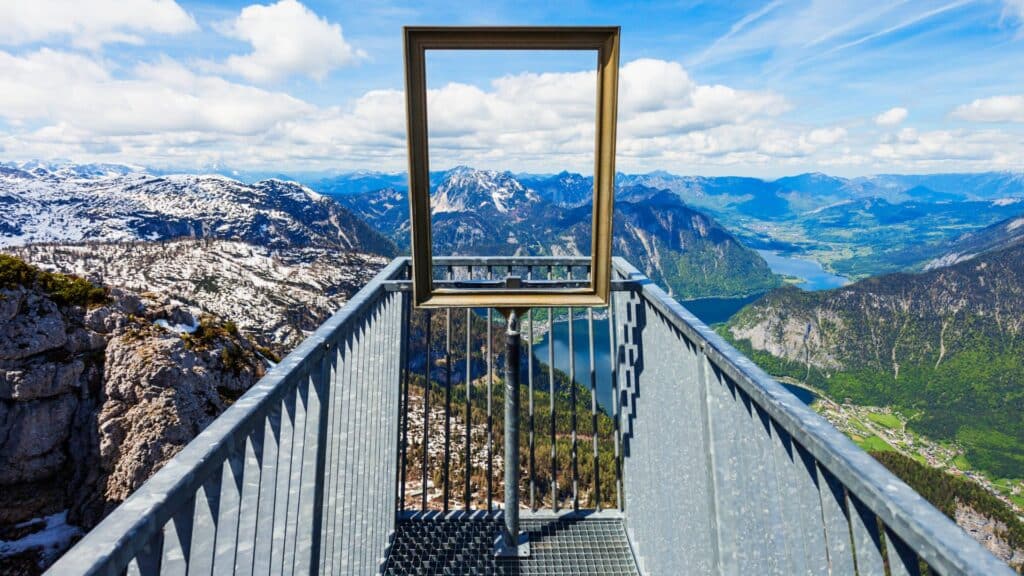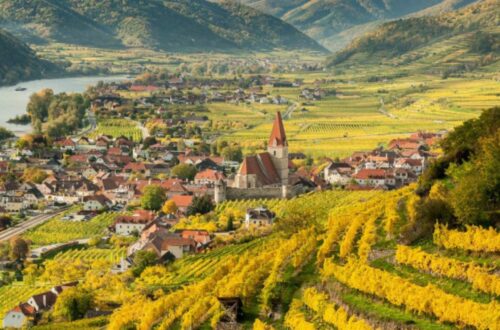
A Quick Guide to the best Austrian wine regions
9 minutes read
Austria—a land of schnitzel, waltzes, and punctual trains. But did you know it’s also home to some of Europe’s most delightful wines? I didn’t either, at first.
Years ago, while visiting my father in Vienna, I confidently ordered a beer, thinking I was blending in with the locals. The bartender gave me a polite but knowing smile and a look that said bless your heart and said, “Actually, we’re more of a wine country.” That was the moment my journey into Austrian wines began.
Since then, I’ve made it a rule to taste local wines whenever I travel. Growing up, my parents took us to a different country every summer, sparking my love for exploration. Now, with family scattered from Paris to Tokyo, wine has become my way of staying connected to the world—and to my roots.
And Austrian wine? Let’s just say it holds a special place in my heart (and my glass).
So, whether you’re a geography whiz or think Austria is somewhere near the Alps (don’t worry, you’re right), join me on this journey through the best Austrian wine regions.
Together, we’ll explore their best-kept secrets, from the crisp whites of Wachau to the bold reds of Burgenland. Grab a glass of Grüner Veltliner and let’s dive into this quick guide to the best Austrian wine regions—you’ll thank me later.

The Austrian wine regions show remarkable diversity. Niederösterreich is home to Grüner Veltliner and Riesling, shaped by varied microclimates. Burgenland produces bold Blaufränkisch and sweet wines, rooted in a rich cultural history. Steiermakr makes aromatic whites with Sauvignon Blanc, grown in stunning southern landscapes. Vienna is know for its Gemsichter Satz, blending tradition with urban winemaking. Last Bergland is a hidden region where vineyards thrive in mountainous terrains.
- An overview of the four best Austrian wine regions
- Niederösterreich (Lower Austria) : Grüner Veltliner’s Happy Place
- Burgenland: Reds, Sweets, and Plenty of Drama
- Steiermark: The Aromatic Frontier
- Vienna: The World’s Only Wine-Capital
- Bergland, the Austrian wine region no one speaks about
- Conclusion : The best Austrian wine regions
An overview of the four best Austrian wine regions
Austria’s wine landscape is divided into four main areas, but here’s the catch—they’re political entities, not natural wine regions like you’d find in France.
Think of it more as a framework drawn on a map than a reflection of each area’s unique “wine identity.” That said, these divisions have evolved to reflect similarities within their vineyards, giving rise to Austria’s renowned DAC system.

Niederösterreich (Lower Austria) : Grüner Veltliner’s Happy Place
Let’s start with the largest—and perhaps most confusing—wine area: Niederösterreich, or Lower Austria.
Despite its name, it’s not in the south but rather the northeast of the country. Why, you ask? Blame history and the Danube River.
Back in the day, Austria was divided into two parts: Oberösterreich (Upper Austria) and Niederösterreich (Lower Austria). The names refer to their position along the river—upstream for Upper Austria and downstream for Lower Austria—not their spots on the map. Geography geeks, rejoice!
Bordered by the Czech Republic and Slovakia to the north and east, Niederösterreich is a powerhouse of dry white wines, particularly Riesling and Austria’s beloved Grüner Veltliner.
These wines aren’t just crisp and vibrant—they’re like a well-tailored suit: sharp, sophisticated, and impossible to ignore, thanks to Niederösterreich’s unique mix of soils and microclimates

Within Niederösterreich, you’ll find eight distinct subregions, each with its own character :
- Wachau : Steep terraces and world-class whites
- Kremstal & Kamptal : Known for their mineral-rich Grüner Veltliners and Rieslings
- Traisental & Wagram : Offering balanced, approachable wines
- Weinviertel : Austria’s first DAC, famous for Grüner Veltliner.
- Carnuntum and Thermenregion : Where reds like Zweigelt and St. Laurent shine.
So, while the name Niederösterreich might make you reach for a map, its wines will leave you reaching for another glass.
Burgenland: Reds, Sweets, and Plenty of Drama
Heading east, we arrive in Burgenland, where the name literally translates to “land of castles.”
And no, it’s not just a charming nickname—it’s a nod to the many castles and fortresses that once dotted the region, standing guard through centuries of conflict and change.
Before World War I, this area was part of the Kingdom of Hungary. After the Austro-Hungarian Empire’s collapse, Burgenland joined Austria, making it a cultural and historical bridge between the two nations.
But here’s a modern twist: some winemakers ended up with vineyards on both sides of the border.
Enter Doppelbesitz in 2015, a uniquely Austrian solution that allows winemakers (such as Gamser) to produce wines using grapes from both Hungary and Austria. Think of it as dual citizenship, but for vines.
Despite being Austria’s least populated state, Burgenland is bursting with history. From ancient Celts and Romans to Ottoman invasions, this region has seen it all. Its storied past adds an extra layer of intrigue to its wines—because who doesn’t love a glass with a side of drama?
Burgenland is best known for two things: bold Blaufränkisch reds and luscious sweet whites made from Welschriesling.

It is subdivided into 5 sub regions :
- Leithaberg : Structured, mineral-driven reds.
- Neusiedlersee : Famous for sweet wines, thanks to the lake’s botrytis-friendly climate
- Mittelburgenland: Blaufränkisch central
- Eisenberg: Elegant reds with earthy complexity.
- Rosalia: The new kid on the block, known for fruity Zweigelt and rosés
Burgenland’s wines are as rich and layered as its history—perfect for anyone ready to explore beyond the ordinary.
Steiermark: The Aromatic Frontier
Down south, where Austria brushes shoulders with Slovenia and Hungary, you’ll find Steiermark—or Styria if you fancy the English version.
Its name is a nod to its past as the “borderland of the Styrians,” marking the historical divide between Slavic and Germanic cultures. A frontier land in both name and spirit, Steiermark is where tradition meets innovation (and a good glass of Sauvignon Blanc)
These days, Styria is as famous for its stunning landscapes as it is for its wines.
Picture the dramatic Dachstein Mountains, the charming streets of Graz (a UNESCO World Heritage site), and vineyards rolling over hills that are as Instagram-worthy as they are deliciously productive.


Fun fact: it’s also a hub for renewable energy and environmental engineering, proving that Steiermark doesn’t just make great wine—it leads the charge into the future.
When it comes to the bottle, Steiermark’s signature style is aromatic whites. Think zippy Sauvignon Blanc and floral Muskateller—the kind of wines that practically demand a sunny afternoon and a second glass.

The region is divided into three subregions :
- Vulkanland: Wines with a fiery personality (and a name that hints at its volcanic soils)
- Südsteiermark : The heart of Styrian winemaking, known for elegant whites
- Weststeiermark: Home of Schilcher, a distinctive rosé made from Blauer Wildbacher grapes
Steiermark’s wines are as dynamic and refreshing as the region itself—perfect for anyone ready to explore Austria’s aromatic side.
Vienna: The World’s Only Wine-Capital
And now, Vienna—the showstopper. It’s the only capital city in the world where vines grow right within its borders. Imagine sipping wine with a view of the skyline and the vineyards that produced it. No big deal, just a casual day in Vienna.
Vienna’s vinous claim to fame is Gemischter Satz, a wine born from the practical genius of early growers.
Back in the day, relying on a single grape variety was a gamble (Mother Nature isn’t always kind). To hedge their bets, they blended grapes from different fields—some slightly underripe, others perfectly ripe, and a few a tad overripe.
The result? A wine that’s rough around the edges but beautifully balanced
Today, Wiener Gemischter Satz is no longer a happy accident but a certified DAC. To wear this badge of honor, the wine must include a blend of at least three grape varieties, with no single variety dominating more than half of the final blend.
It’s Vienna in a bottle: diverse, harmonious, and uniquely charming.
Bergland, the Austrian wine region no one speaks about
Have you heard of Bergland? Probably not—it’s Austria’s most overlooked wine region, but I promise it’s worth your attention.
Nestled in the mountains, Bergland is all about resilience. Winemakers here face challenging terrains but still make wines full of character.
The region is divided into five subregions—Carinthia, Upper Austria, Salzburg, Tyrol, and Vorarlberg—and each has its own personality.
Carinthia offers elegant white Burgundy grapes, Upper Austria shines with Grüner Veltliner, and Tyrol gives us refined Pinot Noir.
These wines may be hard to find, but they’re worth the search.
Conclusion : The best Austrian wine regions
Austrian wine is full of surprises, and for me, it’s been a journey of discovery.
I’ve fallen for Steiermark’s Sauvignon Blancs—their incredible minerality and long finishes make them unforgettable.
Grüner Veltliner? I love the crisp, mineral-driven styles from Kremstal and Kamptal, though the fruity Wachau versions are always a delight.
And the reds? Blaufränkisch from Leithaberg completely stole my heart with its elegance and depth.
As for the sweet wines, Kracher’s Trockenbeerenauslese (TBA) is my ultimate indulgence—pure liquid gold.
Exploring Austrian wine isn’t about knowing it all—it’s about finding what excites you. Whether it’s a crisp white, a bold red, or a luscious dessert wine, there’s something here to spark your curiosity. Why not let Austria surprise you too? You might just find your next favorite bottle.
Where to next?
Why Steiermark’s Sauvignon Blanc is a Must-Try
As a fan of minerality and long finishes, I’m completely hooked on Steiermark’s Sauvignon Blanc. Discover why this region is perfect for Sauvignon lovers like me.
Grüner Veltliner: Kremstal vs. Kamptal vs. Wachau
Grüner Veltliner comes in so many styles. Let’s explore the minerality of Kremstal and Kamptal versus the fruitier notes from Wachau, so you can find your perfect match.
Falling for Blaufränkisch: A Guide to Austria’s Best Reds
I never expected to fall so hard for Blaufränkisch, but the elegance of Leithaberg’s reds completely won me over. Here’s what makes them stand out.
Neusiedlersee: Whre you’ll find my favourite Austrian dessert wine
Ruster Ausbruch is famous, but Kracher’s Trockenbeerenauslese (TBA) is my sweet wine soulmate. Let’s take a closer look at what makes it so special.







